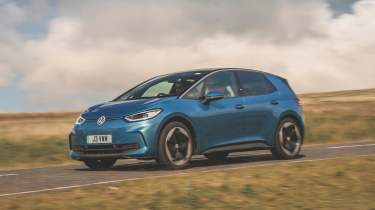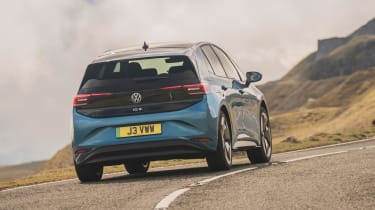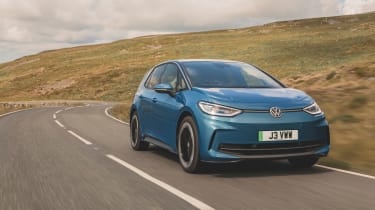Volkswagen ID.3 2025 review – Wolfsburg's everyday EV gets competitive
The ID.3's been updated to address some of its key weak points, and a new range structure makes it more competitive than ever
Volkswagen has some work to do to restore its reputation as a maker of consistently impressive, user-friendly, high-quality products. Its latest generation of cars have faltered in some of the key tenets on which the brand has been built, and Volkswagen recognises this; there’s a sense of urgency to steer itself back on course, as demonstrated by the facelifted ID.3. The new EV grant also goes some way to improving its desirability and affordability, dropping its £30,860 starting price to just £29,360 after the £1500 grant is applied.
Volkswagen accelerated its development schedule to update the ID.3 a couple of years ago, bringing a host of design and quality improvements to its first ground-up electric car. But with a wave of new EV hatchbacks vying for the same slice of the market in right now, has Volkswagen done enough to compete at the sharp end?
> Volkswagen ID.3 GTX Performance 2025 review – an electric Golf GTI?
To be clear, the ID.3 has always been a competent electric car, but some elements – such as its cabin quality, infotainment software and ergonomics – didn’t live up to the standards you’d expect of a premium family hatch. Volkswagen is tackling these head on with the new ID.3, while cleaning up the exterior with a restyled front end and new colours. With stubby overhangs and a short bonnet the ID.3 certainly looks modern and unmistakably battery-powered, and the changes to the nose provide a crisper, more grown up look. That said, if you weren’t a fan of the tall, narrow proportions before, this facelift will do little to change that.
More reviews
Climb inside and the ID.3’s spacious, well packaged cabin layout is also familiar. It’s not as minimalist as a Tesla Model 3, but the low centre storage tunnel, shallow scuttle and front quarter windows give a refreshingly airy feel, and true to Volkswagen’s word, perceived quality has taken a step up. The dashboard is moulded from softer plastic with a faux stitch line across its width, and most of the touch points now have the durable, reassuring feel you’d expect from a Volkswagen (aside from the scratch-prone gloss black surfaces on the door cards and centre console).
The seats deserve a special mention, with excellent lumbar support and a decent range of adjustability to find a comfortable driving position. That said, a few ergonomic oddities remain, ones that should have been addressed as part of the update. The fiddly touch sliders for the volume and temperature controls remain unlit, the haptic steering wheel buttons are prone to accidental presses and most of all, the infotainment software is behind the curve in terms of speed and responsiveness. The graphics are crisp and most of the system’s earlier bugs have been rectified, but it still doesn’t zip through simple tasks as quickly as it should. An upgraded 12.9-inch infotainment display will become available next year which may stamp out most of our complaints.
Twist the drive selector off to the right of the steering wheel and the ID.3 creeps away in silence. As before, drive is sent to the rear wheels via a 201bhp electric motor (there’s no 228bhp version as with the Cupra Born, which rides on the same MEB architecture), and with 229lb ft of torque available from zero rpm, there’s an easy, effortless feel at low speeds. This is true of most EVs of course, but the ID.3 feels very definitely geared towards a low-effort driving style, with the Cupra Born offering a more direct, sporting edge to its steering and ride quality.
If that's what you're after, the ID.3 GTX might hit the spot. With 282bhp – or a Golf R-beating 322bhp in Performance trim – the GTX is Volkswagen's first crack at an EV hot hatch, and costs £46,325. Adaptive dampers, 20-inch wheels and (very) subtle design tweaks come as standard, along with a larger 79kWh battery pack that offers 373 miles of range.
Elsewhere in the range, there are three battery options to choose from: the entry-level 52kWh, middling 58kWh and larger 77kWh packs with peak charging rates of 120kW, 120kW and 170kW respectively. We tested the latter, and while the extra capacity provides a useful range boost (we achieved a respectable 300 miles from a charge against Volkswagen’s 347 mile claim), it pushes the ID.3’s kerb weight close to two tones. Ouch.
The Volkswagen doesn’t spring off the line with the same vigour as some other electric cars, but the measured, gradual build up of acceleration feels appropriate for a hatch with no sporting pretence. The 58kWh model completes the 0-62mph sprint in 7.3sec with the 77kWh lagging six tenths behind, but as is often the case with EVs, higher speeds suck the life out of the performance.
Rolling refinement is good, if not excellent, and the ID.3 does feel a touch more compliant than its Cupra relative, filtering out most lumpen surfaces. The trouble is this doesn’t actually result in a more plush feel overall, as the Volkswagen can feel underdamped through undulations and rough patches of tarmac still rumble through the car; it’s competent but doesn’t feel especially sophisticated.
With the batteries mounted low down and a tight turning circle, the ID.3 feels manoeuvrable and lighter than its near kerb weight might suggest (we tested the heavier 77kWh battery version). The high seating position and light steering make it easy to place and thread through town, but if you’re hoping that the rear-drive layout can conjure some degree of fun and involvement, you’re pretty much out of luck.
Up the speed and it becomes harder to shake the sense of mass, and the ID.3 can feel a little out of its depth on a tight, challenging road, the ESC hastily cutting in to keep the car in check. In the right circumstances – usually through long, constant-load turns – there is a sense of being pushed from the rear rather than pulled from the front, but there’s very little incentive to test the ID.3’s capabilities. The Cupra Born, hardly a firecracker itself, has a wider window of adjustability and is ultimately more satisfying to drive.
Price and rivals
The base-level ID.3 is now the Pure Essential model, costing from £30,860 or £29,360 after the government's £1500 EV grant is applied. While the Cupra Born was once the cheaper option, it now starts at a much higher £35,690 (£34,190 after the EV grant), but the £27,245 MG4 still undercuts the Volkswagen despite the fact it's not eligible for the grant. The standard MG4 is a touch slower to accelerate and offers 218 miles of range against the ID.3’s 266, but as a value proposition it’s hard to ignore – particularly since it’s the more dynamic car of the two. Upgrading to the MG4 Long Range boosts range to 281 miles while keeping the price below £30,000, while Renault’s Megane E-Tech costs pretty much the same as the Volkswagen and achieves 280 miles from a charge.
The larger 79kWh battery ID.3 costs from £36,995 (£35,495 after the grant), and though it does offer larger 19-inch wheels, upgraded seats and faster 170kW charging, it’s fringing on the likes of the Tesla Model 3 and Hyundai Ioniq 5 – both of which are more advanced and more spacious EVs.





